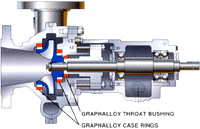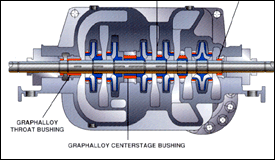
|
| GRAPHALLOY |
| HORIZONTAL
AND VERTICAL PUMPS |
THE
QUESTION..................................HOW MUCH CAN GRAPHALLOY
IMPROVE PUMP OPERATION ?
THE ANSWER.................................SPECIFYING
GRAPHALLOY
PROVIDES REAL ADVANTAGES. |
| What
is GRAPHALLOY ? | |
GRAPHALLOY,
graphite/metal alloy is a self-lubricating bearing
material used by designers and maintaince engineers
to solve the toughest pump applications-from new installations
to retrofitting existing units.
GRAPHALLOY is non-galling, corrosion resistant,
dimensionally stable and performs at temperatures from cryogenic to higher than
1000o F.
GRAPHALLOY allows pumps to servive "run dry"
conditions, slow roll operation and frequent stops/start where metal and plastics
fail.
GRAPHALLOY works in low lubricity, corrosive and sour liquids.The use
of GRAPHALLOY pump wear parts results in lower operating and repair costs and
provides assurance against catastrophic failures. | |
| What
Makes it Work Better | |
FEATURES |
BENEFITS |
|
Self-Lubricating | Handles
low lubricity fluids such as light hydrocarbons, liquefied gases and hot water
in which metallic bearings wear excessively. |
| Hot |
Runs at
temperatures well above the limit of plastic-even in molten metals above 1000o
F and survives thermal shocks of 22 degrees per second down to ambient.
| | Cold |
Perorms
in cryogenic temperatures to -450o F where other materials suffer embrittlement
and seizure. | | Dry
Running | Survives
"loss of pumpage" operation for prolonged periods without either damage
or preventing pump re-start. |
| Wet |
Resists
attack by most corrosive liquids including sulfuric acid, chlorine water, and
caustics. | | Non-Galling |
Permits
closer running clearances between rotating parts resulting in higher pump efficiency
at lower shaft vibration. | | Dimensionally
Stable | Maintains
dimensional stability when submerged, under static pressure loading, and over
wide temperature swings, providing constant running clearance for all operating
conditions. | |
|
| GRAPHALLOY
Reduces Vibration |
 |
Pumps with
mechanical seals have frequent failures due to excessive shaft vibration. Upgrades
using GRAPHALLOY case rings and close clearance throat bushings provide reduced
vibration levels-in one specific case from 1.2 to less than .05 ips. The result
is fewer seal and bearing failures and increased MTBF. This upgrade is recognized
in the current API 682 standard. GRAPHALLOY more than meets this specification.
| |
| GRAPHALLOY
Permits Dry Starts | |
Deep setting
vertical turbine well pumps require pre-lubrication of the standard bronze or
rubber bearings between the low water level and discharge surface. Environmental
concerns have now restricted the use of oil and grease. The alternate of water
from a local source for start-up requires a complicated auxilliary system. The
solution is to use GRAPHALLOY lineshaft bushings which eliminate the need for
aby pre-lubrication by running dry until pump discharge flow is established. At
one installation, the engineer estimated that it would take more than five minutes
for the pumpage to reach the surface discharge from lower water level. GRAPHALLOY
survived this duration with margin to spare. |
| GRAPHALLOY
Extends Life for Continuous Services |
| Self-lubricating
GRAPHALLOY has long been the standard bearing in vertical "can" pumps
in the refinery tank farm area. The typical light hydrocarbon products have poor
lubricity and tendency to "flash". This, combined with recurring "run
dry" operation when the tanks emptied, motivated designers and operators
to search for a replacement of the bronze bearing material. GRAPHALLOY is now
the overwheming choice (confirmed by the API 610 Eighth Edition ) for lower wear
rates and "run dry" survival. | 
| |
| GRAPHALLOY
Survives Frequent Loss of Suction |
| Boiler
Feed pumps for industrial steam generators are frequently subjected to loss of
suction flow during transient switch over. Pumps fitted with metal and plastic
wear parts fail in a few minutes of dry running, while those fitted with GRAPHALLOY
will survive and resume pumping when flow returns without wear parts damage. At
a chemical plant, three pumps experienced 25 failures in eight years at a cost
of $15,000 per failure. Following a GRAPHALLOY retrofit of all pumps, failures
were reduced by 68% and the average repair cost by over 90% during the next five
years. | Top |
|



